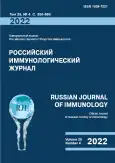Mucosal immunity during rehabilitation in the patients after coronavirus infection
- Authors: Khasanova A.А.1, Kostinov M.P.2,3, Soloveva I.L.1
-
Affiliations:
- Ulyanovsk State University
- I. Mechnikov Research Institute of Vaccines and Sera
- I. Sechenov First Moscow State Medical University (Sechenov University)
- Issue: Vol 25, No 4 (2022)
- Pages: 549-554
- Section: SHORT COMMUNICATIONS
- URL: https://journals.rcsi.science/1028-7221/article/view/120150
- DOI: https://doi.org/10.46235/1028-7221-1190-MID
- ID: 120150
Cite item
Full Text
Abstract
Following the coronavirus infection, a variety of symptoms may persist for a long time. Therefore, an important area of further research is to study the state and response of protective immune mechanisms in the post-COVID period. Our aim was to evaluate the dynamics of mucosal immunity by measuring sIgA in the saliva samples and nasal swabs (sIgA, lactoferrin), as well as efficiency of interferon-alpha-2b (IFNa2b) treatment in the patients after coronavirus infection.
A study was conducted in the patients aged 18 to 60 years (n = 130) at the terms of 1 to 9 months after a coronavirus infection. A control group consisted of conditionally healthy individuals (n = 15). Diagnosis of post-COVID manifestations was carried out by collecting complaints, anamnestic data, physical examination and questionnaire. The state of mucosal immunity in saliva samples and nasopharyngeal mucosal scrapings was evaluated in dynamics as based on determination of sIgA and lactoferrin concentrations by means of enzyme immunoassay techniques prior to administration of local preventive therapy with recombinant IFNa2b, and 1 month after the treatment (“VIFERON”® gel applied intranasally twice a day for 30 days).
The following symptoms of post-COVID syndrome were documented In the study group: joint and muscular pain, shortness of breath, cough, fatigue and weakness, headache and dizziness, anxiety. In the group of patients who received preventive therapy during 1 to 3 months after coronavirus infection, a significantly increased level of saliva sIgA was noted, respectively, 1.84±0.28 to 5.78±1.96 mg/mL. As based on the data obtained with scrapings from nasopharyngeal mucosa, a significant increase in the level of sIgA was revealed in the group subjected to therapy up to 3 months after COVID-19 infection, i.e., from 28.61±3.0 to 39.83±3.85 mg/mL. In the group of patients devoid of preventive therapy, a stable maintenance of the reduced mucosal immunity parameters was found in all time intervals during the period of convalescence. In all observed patients, regardless of the group, a decreased lactoferrin level was found, being two-fold lower than the normal reference values. The incidence of respiratory viral infections in the group without preventive therapy was statistically significant, being registered in 9.2% of cases.
Patients after COVID-19 infection exhibit a persistent decrease in mucosal immunity. Immunological efficacy was observed when using IFNa2b, thus making it possible to recommend it for rehabilitation in this group of patients over the period of convalescence.
Full Text
##article.viewOnOriginalSite##About the authors
A. А. Khasanova
Ulyanovsk State University
Author for correspondence.
Email: albinafeizer@yandex.ru
Postgraduate Student, Department of Infectious Diseases
Russian Federation, UlyanovskM. P. Kostinov
I. Mechnikov Research Institute of Vaccines and Sera; I. Sechenov First Moscow State Medical University (Sechenov University)
Email: albinafeizer@yandex.ru
PhD, MD (Medicine), Professor, Honored Scientist of Russia, Head, Laboratory of Vaccine Prophylaxis and Immunotherapy; Head, Department of Epidemiology and Modern Vaccination Technologies
Russian Federation, Moscow; MoscowI. L. Soloveva
Ulyanovsk State University
Email: albinafeizer@yandex.ru
PhD, MD (Medicine), Professor, Department of Pediatrics
Russian Federation, UlyanovskReferences
- Костинов М.П. Иммунопатогенные свойства SARS-CoV-2 как основа для выбора патогенетической терапии // Иммунология, 2020. Т.41, № 1. С. 83-91. [Kostinov MP. Immunopathogenic properties of SARS-COV-2 as a basis for the choice of pathogenetic therapy. Immunologiya = Immunologiya, 2020, Vol. 41, no. 1, pp. 83-91. (In Russ.)]
- Костинов М.П. Основы иммунореабилитации при новой коронавирусной инфекции (COVID-19): пособие для врачей. М.: МДВ, 2020. 112 с. [Kostinov M.P. Fundamentals of immunorehabilitation in new coronavirus infection (COVID-19). The allowance for doctors]. Moscow: MDV, 2020. 112 p.
- Костинов М.П., Свитич О.А., Маркелова Е.В. Потенциальная иммунопрофилактика COVID-19 у групп высокого риска инфицирования. Временное пособие для врачей. М.: МДВ, 2020. [Kostinov M.P., Svitich O.A., Markelova EV. Potential COVID-19 immunization in high-risk groups. Temporary allowance for doctors]. Moscow: MDV, 2020.
- Goërtz Y.M.J., van Herck M., Delbressine J.M., Vaes A.W., Meys R., Machado F.V.C., Houben-Wilke S., Burtin C., Posthuma R., Franssen F.M.E., van Loon N., Hajian B., Spies Y., Vijlbrief H., van 't Hul A.J., Janssen D.J.A., Spruit M.A. Persistent symptoms 3 months after a SARS-CoV-2 infection: the post-COVID-19 syndrome? ERJ Open Res., 2020. Vol. 6, no. 4, 00542-2020. doi: 10.1183/23120541.00542-2020.
- Isho B., Florescu A., Wang A.A., Gommerman J.L. Fantastic IgA plasma cells and where to find them. Immunol. Rev., 2021, Vol. 303, no. 1, pp. 119-137.
- Jung Y.H., Ha E.H., Choe K.W., Lee S., Jo D.H., Lee W.J. Persistent symptoms after acute COVID-19 infection in omicron era. J. Korean Med. Sci., 2022, Vol. 37, no. 27, e213. doi: 10.3346/jkms.2022.37.e213.
- Legrand D. Overview of lactoferrin as a natural immune modulator. J. Pediatr., 2016, Vol. 173 Suppl., pp. S10-S15.
- Rahman S., Montero M.T.V., Rowe K., Kirton R., Kunik F. Jr. Epidemiology, pathogenesis, clinical presentations, diagnosis and treatment of COVID-19: a review of current evidence. Expert Rev. Clin. Pharmacol., 2021, Vol. 14, no. 5, pp. 601-621.
- Russell M.W., Moldoveanu Z., Ogra P.L., Mestecky J. Mucosal immunity in COVID-19: A neglected but critical aspect of SARSCoV-2 infection. Front. Immunol., 2020, Vol. 11, 6113. doi: 10.3389/fimmu.2020.611337.
Supplementary files







